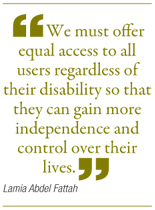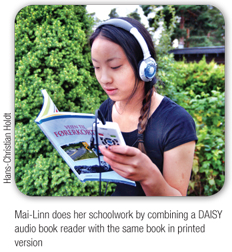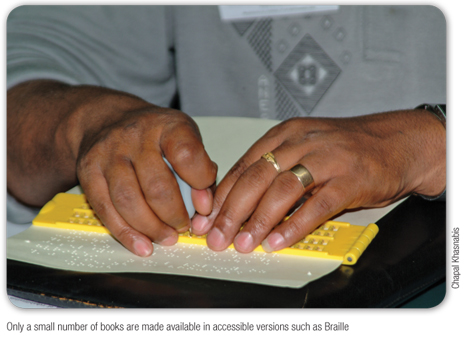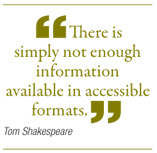NEWS
Unlocking the power of books for people with disabilities
The emergence of digital talking books in Arabic is one of a number of exciting developments. Lynn Itani reports.
Mohamed Sobhi has been struggling to get into books for most of his life. Unable to read normal size text because of his low vision a bilateral impairment that cannot be corrected by lenses, therapy or medical/surgical interventions he started out by using photocopiers to enlarge the text, a time-consuming process that also generated reams of paper. When scanners came along he dispensed with copying and simply displayed an enlarged view of the text on his monitor. But as he progressed through college, Sobhi, now 28, and a resident of Alexandria, Egypt, found that his options were narrowing again.
"I had to revert more and more to the library shelves for reference materials, some of which could not be borrowed, and copyright restrictions did not allow for photocopying," he says. Just when he was really getting started, he hit a wall. For 31-year-old Heba Kholeif, also an Alexandria resident, the wall was even higher. "I am totally blind," Kholeif says, "and that makes it nearly impossible to read standard printed materials."

According to the World report on disability, published by the World Health Organization (WHO)/World Bank in June, more than one billion people live with some form of disability. Disability issues tend to be discussed in terms of barriers to physical access, and while it is true that many built environments, including public spaces and transport systems present obstacles of this kind, one of the biggest barriers faced in what is often described as "the information age" is the lack of access to information. For Sobhi, Kholeif and other people living with visual impairment, reading standard printed books can be particularly challenging.
But the situation is beginning to change. For Sobhi and Kholeif the most important development has been the development of the Digital Accessible Information SYstem (DAISY) and its relatively recent emergence in Arabic. DAISY books are made up of a combination of text, graphics and audio files, providing users with an experience similar to that of flipping through a printed book. Users can read DAISY books on specialized devices or download software to use on a computer. In the same way that sighted people might glance at a heading and skip to the section of interest to them, DAISY books are designed so that users can navigate through them with flexibility.

As Hiroshi Kawamura, President of the DAISY Consortium, an international non-for-profit association that develops, maintains and promotes international DAISY standards, explains, "DAISY readers give the user a great deal of control" because they can be navigated by sentence, paragraph and page.
It was this interactive capacity that caught Kholeif 's attention when she first heard about DAISY in 2004 in connection with the Swedish Library of Talking Books and Braille, a government body that, in collaboration with local libraries, provides access to printed materials for people with print disability. When in 2005 the Swedish Library offered a DAISY course at the Bibliotheca Alexandrina (formerly the Library of Alexandria), Kholeif jumped at the chance to learn more about it. "The course was very intensive," she says, "but also very useful." Sobhi was also an early convert to the DAISY system, having worked hard to develop an understanding of the different screen readers and text-to-speech software packages that had become available before DAISY's arrival.
While the intelligence and determina-theca Alexandrina, notably with regard to the establishment in 2007 of the first Arabic DAISY Digital Talking Book Library for the Blind and Print-Disabled. Since then the Bibliotheca Alexandrina has established a fully-equipped, professional recording studio and acquired DAISY software and hardware tools. "In working with DAISY, it is at the forefront of making publications accessible in Arabic, as very few are currently available," says Julia D'Aloisio, a technical officer who works on accessible publishing at WHO.
"The project is very challenging because of the complexity of the Arabic script," says Lamia Abdel Fattah, acting chief librarian at the Bibliotheca Alexandrina, who is proud to announce that to date the project team has produced more than 80 Arabic DAISY books. For Abdel Fattah, access to information is above all an empowerment issue. "We must offer equal access to all users regardless of their disability so that they can gain more independence and control over their lives," she says.
Despite the encouraging developments in Alexandria, much more needs to be done to spread the word about digital talking books and other accessible formats. According to Vision IP, an initiative of the World Intellectual Property Organization (WIPO) committed to improving access to information, less than 5% of books become available in accessible formats such as Braille or audio formats within the first year of publication, while 33% of children with visually impairments and 47% of partially sighted students are unable to obtain books in the formats they require. "There is simply not enough information available in accessible formats," says Tom Shakespeare, a technical officer in the Disability and Rehabilitation team at WHO, who was an editor and author of the World report on disability.


For 18-year-old Mai-Linn Holdt, a resident of Oslo, Norway who has a severe form of dyslexia, nothing short of total accessibility is acceptable, starting with screenreader-enabled web sites and books available in DAISY format. "Even in most western countries, one has to turn to the "blindlibraries" to get books in DAISY format," Holdt says. "Young kids with dyslexia would like to do as their friends [without visual disabilities] do; go to the local library, look over the shelves and then get both the printed book and the DAISY book at the counter."
According to Shakespeare, this vision may become reality in the not-too-distant future. Producing accessible formats, such as DAISY, is made easier and more efficient when publishers adopt an XML based work-flow. XML, or extensible markup language, allows publishers to produce multiple book formats cost-effectively from a single source, including accessible ones such as ebooks, DAISY or large print books.

Many publishers, including WHO, are leveraging this technology to publish in accessible formats. As Shakespeare points out, the World report on disability was published with a summary that is available in DAISY as well as in other accessible formats, including accessible PDF (portable document format), Braille and EasyRead versions in all six United Nations languages. "We believe this is the most accessible report in the history of WHO, probably of the UN itself," Shakespeare says.
Meanwhile the rapid development of EPUB, a widely used open ebook standard promises to open even more books to people living with visual impairments. "The next version of EPUB (EPUB 3) converges with DAISY," says Melanie Lauckner from WHO Press. "For people with visual impairments this is fantastic as, with a suitable reader, they will have access to all the publications generated in EPUB3."
Access to information is a human right, and defined as such in the United Nations Convention on the Rights of Persons with Disabilities, which to date has 149 signatories and came into effect in May 2008. The Convention calls for the full realization of the rights and fundamental freedoms for all people with disabilities, including their right to access information.
The development of tools like DAISY and accessible ebooks brings the realization of those rights closer, but they are only tools and of value in so much as they are made available by the people who need them. In the words of singer Stevie Wonder, an active supporter of WIPO's Vision IP initiative, we need to give people living with disability "the tools to think their way out of poverty and the darkness that is created when the mind does not have access to something as simple, but as powerful as a book". 
